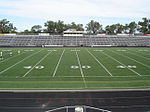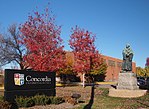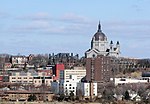Selby Avenue
Harv and Sfn no-target errorsStreets in Saint Paul, Minnesota

Selby Avenue is a street in Saint Paul, Minnesota, United States, that runs east–west from Summit Avenue near downtown toward the Mississippi River. The street runs through the Summit-University and Union Park neighborhoods. The street, especially between Dale Street and Snelling Avenue, has been associated with Saint Paul's black community. The far eastern end of the street has historically been more densely developed and architecturally significant.
Excerpt from the Wikipedia article Selby Avenue (License: CC BY-SA 3.0, Authors, Images).Selby Avenue
Selby Avenue, Saint Paul Union Park
Geographical coordinates (GPS) Address Phone number Website Nearby Places Show on map
Geographical coordinates (GPS)
| Latitude | Longitude |
|---|---|
| N 44.946666666667 ° | E -93.150555555556 ° |
Address
Pizza Lucé (Pizza Luce Saint Paul)
Selby Avenue 1183
55104 Saint Paul, Union Park
Minnesota, United States
Open on Google Maps









